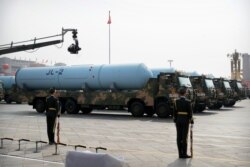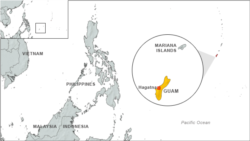The inability of the United States to adequately push back against China’s growing military might is spurring Beijing to accelerate its plans to remake the current international order in its image, a top U.S. military commander told lawmakers Tuesday.
Concerns about China’s aggressive behavior are not new — U.S. military and intelligence officials repeatedly warned about Chinese military investment, disinformation, and espionage and cyber operations — under former U.S. President Donald Trump. But the admonitions have taken on a renewed urgency under current President Joe Biden, whose defense secretary has repeatedly labeled China a “pacing threat.”
"I worry they're accelerating their ambitions to supplant the United States and our leadership role in the rules-based international order," Adm. Philip Davidson, commander of U.S. Indo-Pacific Command, testified before members of the Senate Armed Services Committee.
“They’ve long said that they want to do that by 2050,” he said. “I’m worried about them moving that target closer.”
Davidson, who is set to retire later this year, has spent the past few weeks trying to bring more attention to the danger posed by an ever-bolder China.
On Tuesday, he called China "the greatest long-term strategic threat to security in the 21st century,” and he echoed earlier warnings about an erosion of “conventional deterrence” against Beijing.
"The military balance in the Indo-Pacific is becoming more unfavorable for the United States and our allies," Davidson said. "With this imbalance, we are accumulating risk that may embolden China to unilaterally change the status quo before our forces may be able to deliver an effective response.”
U.S. officials warn that China’s military is in some cases replacing the combination of economic incentives and coercion that once defined Beijing’s approach to the global power competition.
"You're going to find a very global, expeditionary Chinese military that will be there to step in anywhere they think China's interests are jeopardized," U.S. Indo-Pacific Command’s top intelligence officer, Navy Rear Adm. Michael Studeman, told a virtual conference last week.
And officials fear that approach will likely be strengthened as China continues to close the capability gap with the U.S. military.
China is expected to increase its defense spending by 6.8% in the coming fiscal year. Some projections even envision the Chinese navy being able to outgun the U.S. in the Indo-Pacific, from a 3-1 advantage in aircraft carriers up to a 54 to six advantage in modern, multimission combat ships, by 2025.
Officials and lawmakers have likewise voiced concern about China’s growing nuclear capabilities.
The U.S. Defense Intelligence Agency has said China is likely “to at least double the size of its nuclear stockpile” over the next decade. Since then, top officials at U.S. Strategic Command have warned that estimate might be conservative, and that Beijing could triple or even quadruple its nuclear weapons stockpile in that time frame.
Davidson said there is every indication that if China believes it has an advantage, it will use it.
“I see them developing systems, capabilities and a posture that would indicate they are interested in aggression," he said, pointing to how Beijing is already dealing with Hong Kong, the Line of Actual Control with India, the Uighurs in Xinjiang, and Tibet.
Davidson warned that Taiwan and Guam could be next.
"Taiwan is clearly one of their ambitions,” he said. “I think the threat is manifest during this decade. In fact, during the next six years."
As for Guam, Davidson told lawmakers that the U.S. island territory “is a target today.”
“China's own air force has put out a propaganda video showing their H-6 bomber force attacking Anderson Air Force Base at Guam, and distributed that quite publicly,” he warned. “We're seeing Chinese naval deployments of surface task groups and submarines that make circumnavigations of Guam and the Commonwealth of the Northern Marianas. And of course, we see the vast asymmetry of a very large ballistic missile force that China has.”
Davidson urged lawmakers to support continued weapons sales to Taiwan and advocated for installing an Aegis Ashore missile defense facility on Guam.
The $1.6 billion system is one of the top priorities in a five-year, $27.3 billion plan for Washington’s Pacific Deterrence Initiative (PDI), an effort that was established as part of last year’s National Defense Authorization Act (NDAA).
“Maintaining momentum behind the PDI will be a key focus of this committee as we begin work on this year's NDAA,” said Senate Armed Service Committee Chair Jack Reed.
U.S. military officials and lawmakers are also pinning some of their hopes on diplomacy and improved relations with key allies to successfully counter China.
Davidson said the newly formed so-called “Quad,” set to bring together the U.S., India, Japan and Australia, could bode well for efforts to push back against Beijing.
"I'm quite encouraged by the potential power of an organization like the Quad might bring," he said.
White House press secretary Jen Psaki told reporters Tuesday that Quad leaders will meet virtually on Friday, with talks focused on the COVID-19 pandemic, economic cooperation and climate change.










